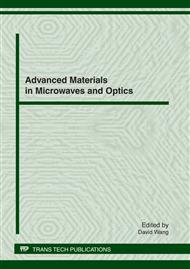[1]
D. Anthony, D. Genio, The dust settles on water vapor feedback, Science, vol. 296, no. 5568, pp.665-666, 26 Apirl (2002).
DOI: 10.1126/science.1071400
Google Scholar
[2]
A. Raval, V. Ramanathan, Observational determination of the greenhouse effect, Nature, vol. 342, pp.758-761, 14 Dec. (1989).
DOI: 10.1038/342758a0
Google Scholar
[3]
S. Akatsuka, W. Takeuchi, H. Sawada: Estimation of precipitable water distribution over northeast Asia using NOAA AVHRR. Asia Conference on Remote Sensing 2008, Colombo, Sri Lanka, (2008).
Google Scholar
[4]
W. Wang, X. Sun, R. Zhang, Z. Li, Z. Zhu, H. Su, Multi-layer perceptron neural network based algorithm for estimating precipitable water vapor from MODIS NIR data, Int. J. Remote Sensing, vol. 27, pp.617-627, (2006).
DOI: 10.1080/01431160500227706
Google Scholar
[5]
J.A. Sobrino, J. EI Kharraz, Z.L. Li, Surface temperature and water vapor retrieval from AIRS data, Int. J. Remote Sensing, vol. 24, pp.5161-5182, (2003).
DOI: 10.1080/0143116031000102502
Google Scholar
[6]
N. Chrysoulakis, Y. Kamarianakis, L. Xu, Z. Mitraka, J. Ding, Combined use of AIRS, AVHRR and radiosonde data for the estimation of spatio-temporal distribution of precipitable water, J. Geophys. Res., vol. 113, D05, 101, (2008).
DOI: 10.1029/2007jd009255
Google Scholar
[7]
M. Chahine, H. Aumann, M. Goldberd, L. McMillin, P. Rosenkranz, D. Staelin, L. Strow, J. Susskind, AIRS Algorithm Theoretical Basis Document, AIRS-Team Retrieval for Core Products and Geophysical Parameters Level 2 (version 2. 2), Availabel from: < http: / eospso. gsfc. nasa. gov/eos_homepage/for_scientists/atbd/docs/AIRS/atbd-airs-L2. pdf>, pp.59-154, (2001).
DOI: 10.1109/tgrs.2002.808356
Google Scholar
[8]
M.G. Divakarla, C.D. Barnet, M.D. Goldberg, L.M. McMillin, E. Maddy, W. Wolf, L. Zhou, X. Liu., Validation of atmospheric infrared sounder temperature and water vapor retrievals with matched radiosonde measurements and forecasts, J. Geophys. Res., vol. 111, D09S15, (2006).
DOI: 10.1029/2005jd006116
Google Scholar
[9]
J. Susskinda, R. Atlasa, C. Barnetb, J. Blaisdellc, et al., Current results from AIRS/AMSUA/HSB, Proceedings of Thirteenth International TOVS Study Conference, (2003).
Google Scholar
[10]
D.C. Tobin, H.E. Revercomb, R.O. Knuteson, B.M. Lesht, et al., Atmospheric radiation measurement site atmospheric state best estimates for atmospheric infrared sounder temperature and water vapor retrieval validation, J. Geophys. Res., vol. 111, D09S14, (2006).
DOI: 10.1029/2005jd006103
Google Scholar
[11]
C. Otlle, M. Stoll, Effect of atmospheric absorption and surface emissivity on the determination of land temperature from infrared satellite data, Int. J. Remote Sensing, vol. 14, pp.2025-2037, (1993).
DOI: 10.1080/01431169308954018
Google Scholar
[12]
S. Hsu, T. Masters, M. Olson, M. Tenorio, T. Grogan, Comparavtive analysis of five neural networks models, Remote Sens. Rev., vol. 6, pp.319-329, (1992).
DOI: 10.1080/02757259209532159
Google Scholar
[13]
K. Hornik, M. Stinchcombe, H. White, Multilayer feedforward networks are universal approximators, Neural Netw., vol. 2, pp.359-366, (1989).
DOI: 10.1016/0893-6080(89)90020-8
Google Scholar
[14]
J. Park and I. Sandberg, Universal approximation using radial-basis-function networks, Neural Computation, vol. 3, p.246–257, (1991).
DOI: 10.1162/neco.1991.3.2.246
Google Scholar
[15]
E. E Borbas, S.W. Seemann, University of Wisconsin-Madison, Nov. (2005).
Google Scholar
[16]
Aires, F., W. B. Rossow, N. A. Scott, and A. Chedin, Remote sensing from the infrared atmospheric sounding interferometer instrument: 1. Compression, denoising, and first-guess retrieval algorithms, J. Geophys. Res., 107(D22), 4619, (2002).
DOI: 10.1029/2001jd000955
Google Scholar


